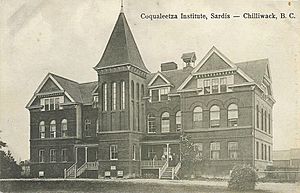Coqualeetza Indian Hospital facts for kids
The Coqualeetza Institute, located in Sardis, British Columbia, has a long and complex history. It sits on the traditional lands of the Stó:lō peoples. Over the years, it has served as a residential school, a hospital for people with tuberculosis, and is now a cultural center.
Contents
A Place of Healing: Coqualeetza Hospital
The Coqualeetza Indian Hospital started as a special ward for Indigenous peoples suffering from tuberculosis (TB). TB was a serious lung disease that affected many people at the time. This hospital was created from the former Coqualeetza Residential School. It officially opened its doors as a hospital on September 2, 1941.
The hospital was first managed by the Department of Indian Affairs. Later, in 1946, the Department of National Health and Welfare took over its management.
In 1948, a fire caused a lot of damage to the hospital building. Even so, people in Sardis worked hard to keep Coqualeetza in their community. By 1957, it was recognized as one of the best hospitals in the Fraser Valley area.
As new medicines made tuberculosis easier to treat, the need for special TB hospitals decreased. Coqualeetza Hospital closed on September 30, 1969. The administrator, James Thompson, believed that having separate hospitals for Indigenous people was no longer helpful.
From School to Hospital: Early Years
The story of Coqualeetza began even earlier, in 1886. A Methodist missionary named Charles Montgomery Tate started a day school here. He later opened a residence for students in 1887. By 1894, his family home became the Coqualeetza boarding school.
A fire damaged the day school in 1891. It took two years to rebuild with help from church groups.
The Residential School Era
From 1914 to 1934, George H. Raley was the principal of the Coqualeetza residential school. These schools were part of a system designed to separate Indigenous children from their families and cultures. The goal was to make them adopt Canadian customs.
The school building was large, with classrooms, dormitories (sleeping areas) for boys and girls, and offices. It was far from many Indigenous communities, so families often found it hard to visit their children.
Students at Coqualeetza were made to wear the same clothes and have the same haircuts. They were not allowed to wear their traditional clothing or speak their Indigenous languages. If students tried to practice their own customs, like dancing or speaking their language, they were often punished. This could include physical punishment or being isolated. For example, one staff member was known to punish students by forcing them to eat soap.
Boys and girls were kept separate at the school. They had different areas for activities, and staff tried to stop them from spending time together. Some students were even expelled for trying to form friendships with students of the opposite gender.
The residential school officially closed in 1940. The remaining students were sent to another residential school. Sadly, records show that at least twenty-one children died while attending Coqualeetza.
Fighting Tuberculosis: The TB Ward
The Coqualeetza Institute was home to Canada's first "preventorium" for Indigenous children with tuberculosis. This was a place to isolate children who tested positive for TB to prevent the disease from spreading. The site was chosen because many students there had tested positive for TB.
In 1935, a farm building was changed to house fifteen students with TB. When it became Coqualeetza Indian Hospital, it could hold up to 175 patients. Tuberculosis had a much greater impact on Indigenous peoples.
The hospital also had a special program for TB patients. It taught them how to make traditional Indigenous crafts, like totem poles and beadwork. Patients also made small ornaments that were sold. The money helped buy more materials, and the creators received a small weekly payment.
Coqualeetza was very important in British Columbia because it had so many beds for TB patients. In 1943, it held 170 of the 270 TB hospital beds in the province, which was more than half.
A Hub for Culture: Today's Coqualeetza
After the hospital closed, studies were done to see if the building could become a community center for the Stó꞉lō peoples. In 1970, Coqualeetza was transformed into a cultural education center.
Today, its main purpose is to "promote, preserve, and interpret" Stó꞉lō culture, language, and traditions. It helps keep the rich heritage of the Stó꞉lō people alive for future generations.
Images for kids



